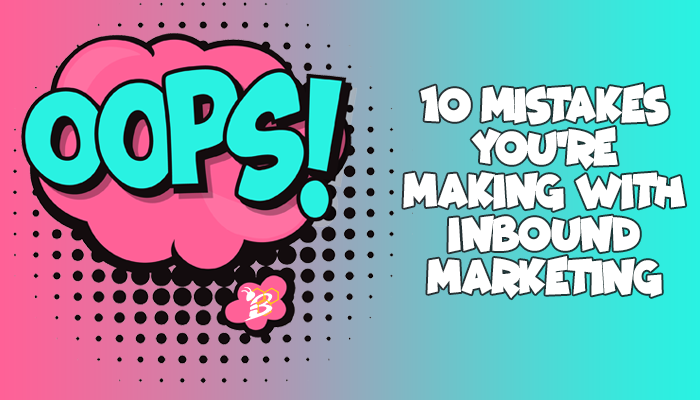When we get asked to look over existing inbound marketing strategies that companies are using to drive sales through the conversion funnel, we see the same mistakes pretty frequently. Some of them are pretty easy fixes, while others require some more time, effort, and training.
Let’s review some of the most common inbound marketing mistakes we see and how you can fix them.
- Poor strategy — not having a strong inbound marketing plan.
- Setting unrealistic goals.
- Using a weak lead scoring system.
- Not maintaining a blog — or maintaining a bad blog.
- Social media that is disconnected and outdated.
- Sending email blasts to every one of your subscribers.
- Trying to be everything to everyone.
-
Not having a method for testing, evaluating, getting feedback, and adjusting your plan.
1. Poor strategy — Not having a strong inbound marketing plan.
This problem manifests itself in a number of different ways, but the symptoms are all the same: poor planning, inconsistent results, and uncertainty about what to do next. When we work with a company, one of the first steps is to create a growth plan.
This plan provides you with a complete analysis of your company’s current marketing initiatives — SEO, content, website, social media, buyer personas, and competitor analysis. From this analysis, a data-driven series of realistic marketing and sales goals, and strategies to meet those goals, along with the training and support needed to accomplish those goals.
When a company lacks an airtight strategy, it leads to many of the other problems on this list. A growth plan uncovers gaps in your inbound marketing strategy and identifies areas of improvement for a strong inbound marketing plan.
2. Setting unrealistic goals.
Inexperienced inbound marketers often hear about incredible results from other companies, which is why they’re excited about developing an inbound plan in the first place. However, this excitement sometimes causes people to get ahead of themselves. Setting unrealistic goals, like tripling your conversion rate in a month or becoming the top search result on Google in a short period of time, can lead to disappointment and frustration.
When your inbound marketing strategy is created around unrealistic goals, your short-term strategies are often mismatched, and you end up spending time and money on all the wrong things. Setting realistic, challenging goals should be your priority.
The Importance of Setting SMART Marketing Goals
3. Using a weak lead scoring system.
Lead scoring can be a secret weapon for your business, but only if it’s done well. When you score a lead, you are essentially examining data about your prospective buyer to determine how much time you should spend on selling your product or service to them. It helps your sales and marketing teams understand which stage of the funnel someone is in and helps your sales team prioritize who they should spend their time on - those at the bottom of the funnel.
Lead scoring sounds awesome — who wouldn’t want to have a strong method for determining the likelihood of a prospect converting into a buyer? However, lead scoring can also be a huge time waster if it’s not done well or if it’s treated as a one-size-fits-all approach. Following well-defined lead scoring guidelines can make a huge difference in your company’s profitability.
Lead Scoring 101: How to Prioritize Leads in Your Pipeline
4. Not maintaining a blog — or maintaining a BAD blog.
The perception of blogging has changed dramatically over the years. Today, most businesses make one of the following mistakes — either they think their blog is a place to tell everyone how great they are, place quantity over quality, or they start blogging and give up after a couple of months because of the time commitment.
Yes, blogging does require a large time commitment, but it is all worth it if you're doing it right. You should aim to blog at least once per week with educational and helpful content that speaks to your prospect's and customers' pain points. Your blog is not a place to brag or try to make a sale. The importance of brand voice and authority must not be overlooked. Blogging is your opportunity to educate prospective and current customers, establish yourself as an industry expert, and increase organic traffic to your website.
5. Social media that is disconnected and outdated.
It’s not enough to create Facebook, Twitter, LinkedIn, Instagram, and TikTok accounts with your company’s information on them. Your ideal customer might spend most of their time on LinkedIn or Instagram, depending on your product or service and the demographics of your buyer personas. It's important to target the right buyer on the right account. Your social media plan should be cohesive between multiple accounts and targeted to the specific buyer personas found on each platform.
Your social media plan should also include things like targeted ads, retargeting, and dynamic content. However you can do all of these things, but if you aren't interacting with your audience, your efforts will be wasted. Creating high levels of community engagement with plenty of likes, comments, and shares will help you grow your social following and increase your visibility as a business.
6. Sending email blasts to every one of your subscribers.
Promotional emails clutter up all of our email inboxes, leading us to unsubscribe. If you're not providing personalized and relevant content to your email subscribers, you can easily annoy and lose your prospects. However, email is still an important part of the inbound marketing strategy and one of the most successful marketing tactics when done well.
In HubSpot, excessive hard bounces, unsubscribes, spam reports, and direct complaints will get your email-sending ability suspended. Here's a quick look at HubSpot's rules:
- Hard bounces: HubSpot's hard bounce limit is 5%. For reference, many ISPs prefer bounce rates to be under 1%.
- Spam reports: HubSpot's spam complaint rate limit is 0.1% (1 in 1,000 messages sent). Spam reports are when a recipient clicks the spam button to report spam while viewing your email in their inbox or drags the email into their junk folder.
- Direct complaints: if any direct complaints are sent to HubSpot's abuse desk, marketing email sending may be suspended in your account.
- Unsubscribes: HubSpot's unsubscribe rate limit is 3%.A healthy unsubscribe rate is less than 1%.
5 Email Marketing Campaign Best Practices That Work
7. Trying to be everything to everyone.
When you try to be everything to everyone, you end up being nothing to anyone. You are not the right match for every single prospective customer. Your company is unique, and you should try not to lose sight of that. Companies that try to be everything to everyone end up being one of two things: either really generic or really overwhelming.
You should prioritize the customer profiles of people who are the most likely to convert into buyers, and then market to those people. Don’t waste time trying to sell to every single person who sees your company’s name. Instead, focus on the people who have a much higher likelihood of becoming a customer.
8. Not having a method for testing, evaluating, getting feedback, and adjusting your plan.
Having an effective marketing plan in place is great, but what is your system to evaluate its successes and failures? What is the protocol for looking at a Facebook ad campaign that has just wrapped up and deciding what its strengths and weaknesses were? Why did it succeed where it did?
What factors contributed to its weak performance in other areas? How will you change your next ad based on the data you collected from this one? People who forget to do this important closing task at the end of a campaign are never going to advance the way that highly effective evaluators do.
Identifying metrics and key performance indicators when creating your campaign will help you understand how well your strategies are working. If you don't consider what key performance indicators to monitor when you create your marketing strategy, you won't have any way to determine where your campaign was successful and how to optimize it for better performance.
How to Create a Strong Sales and Marketing Strategy
9. Lacking experience.
To be fair, everybody starts out without experience. However, when you have a gap in your experience and knowledge, you need to do what you can to fill that gap. Sometimes, that may mean taking classes. Other times, it’s hiring a consultant or outsourcing your inbound marketing work.
What you don’t want to do is trust that just because someone has some cursory familiarity with the concepts of inbound marketing, they are the right fit for your needs. Make sure the decision maker is experienced or guided by those with experience so that you can avoid beginner mistakes.
10. Being too “salesy” in your SEO content.
When crafting inbound content, you want to avoid developing an off-putting, sales-centric tone in your writing. Prospective customers pick up on subtle cues that tell them what you’re writing is really just an ad.
You don’t want to hide the fact that you’re advertising a product or service — that looks sneaky and is pretty obvious to savvy consumers — but you do want to keep from making your prospective customer feel like your whole point is to sell something to them. Instead, content should be informative, interesting, educational, and relevant.
5 Reasons Your Content Marketing Strategy Sucks
All of these issues are important to consider when developing your inbound marketing plan. Novices should be aware of these pitfalls in order to avoid them. Whether it’s something you can fix quickly or something you need outside help to remedy, focusing on one or two of these at a time can start improving your effectiveness and efficiency as an inbound marketer.











